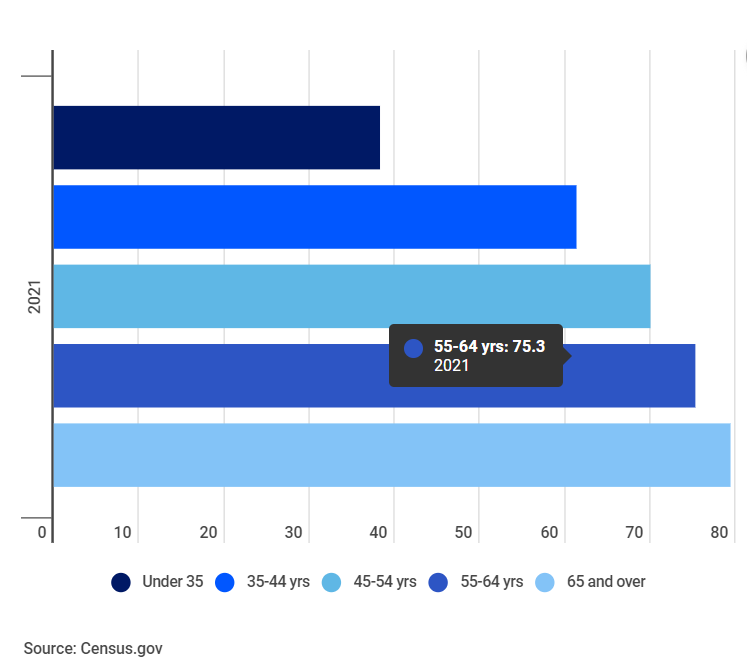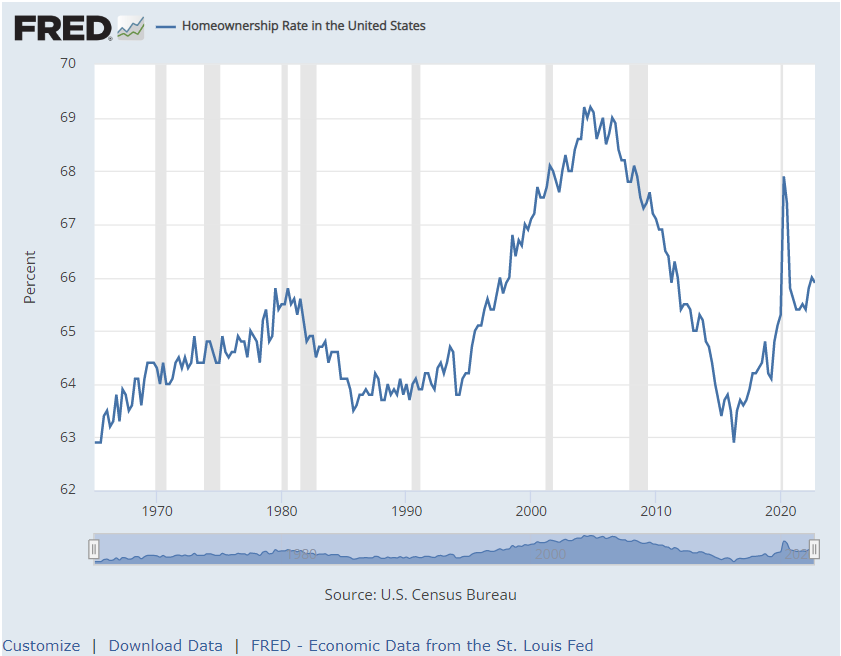
No matter how much buying a house makes sense for your long-term financial well-being, buying your first house can often just seem expensive and totally out of reach. That leads to many younger people putting off buying a home until later in life than they might have, if the costs were lower.
But there are plenty of younger people buying homes. Nearly 40% of people under 35 own a home, so it’s by no means impossible or entirely unaffordable.

Homeownership Stats by Age
Infogram
As you can see in the graph above, the homeownership rate goes up to just over 60% for those between the ages of 35-44, which is about where the homeownership rate is for the entire US, regardless of age.
Interestingly, if you look at the chart below, the homeownership rate has actually hovered between 62 and 68 percent since 1965. So, basically, the wheelhouse for homeownership begins around 35 years old.

This means that buying a home when you’re under 35 gives you some precious years of building equity, wealth, and long-term financial well-being, while your peers are still renting, or living at home.
Here’s How the Government Is Making It More Affordable to Do So…
Buying your first home is about to become a little more affordable due to a recent move by the Department of Housing and Urban Development (HUD), through the Federal Housing Administration (FHA), to reduce how much mortgage insurance premiums are for FHA borrowers.
FHA loans are a common type of mortgage for many first-time buyers. They are insured by the federal government, and have less strict guidelines, which are helpful for a buyer with lower credit score, or a lower down payment to buy a home. However, when you put a lower down payment on a home, you have to pay mortgage insurance. The premiums for that mortgage insurance is what the FHA is lowering, and they will now be $800 less per year on average.
Not a bad chunk of change to save on a yearly basis. That said, it might seem like a drop in the bucket of what you’d need in order to make buying a home affordable.
If you want to join the ranks of the approximately 40% of younger homeowners, here are a few other ways to shave down the cost of buying your first home and making it even more affordable:
- You don’t need to buy a big house. The chances are, you’ll end up selling your first home and buying another (or two) in your lifetime. So don’t think you need to be able to buy a house that will suit your future needs. Focus on buying a home that meets your needs for now, and in the near future. And don’t get caught up in trying to impress your friends and family with how big of a house you have, because owning one at a younger age is impressive enough.
- Furnish it within a budget. Another great reason for buying a smaller house is that you don’t have to spend as much to furnish it! The bigger the house, the more rooms it has… and the more furniture you have to buy. But even when you buy a smaller house and need less furniture, you should still try to furnish it on a budget. Look for good deals and discounts, rather than racking up a credit card bill that you’ll be paying off longer than the more expensive furniture will last.
- It doesn’t have to be your ideal location. If you have a specific town, city, or neighborhood you aspire to buy a home in, but it’s more expensive than you can afford, you’re probably better off buying somewhere you can afford right now vs. waiting to afford where you eventually want to live. Time, inflation, and rising home prices have a way of outpacing the ability to save for enough of a downpayment to buy a more expensive house. You’re better off buying in another area now, and letting those economic factors help you grow your wealth and equity so you can trade up to a more expensive home in the area you truly want to live in a few years.
- Try and beat what you would pay in rent. This is a double-dip scenario: you pay less per month than you would in rent, and accrue equity and wealth while doing so! It’s not always possible, but sometimes you can actually buy a home for less than you currently pay in rent. But the key word here is “try.” You may need to look harder, or perhaps be less picky in order to make it happen, but it can be worth the sacrifice and effort! Doing this can put you way ahead of where you would’ve been financially in a lot less time.
- Learn to be handy. Owning a home comes with the need to fix, replace, or update things on occasion. Some things you’ll need a pro to fix, and you should budget for that. But spending a little time learning how to fix, replace, or update something on your own can save you a lot of money. YouTube (and other online platforms) have made it possible to watch a how-to video on almost anything! (Heck, a woman and her children built an entire house just by watching them!)
Combining a few of those tips—along with the lower mortgage insurance premiums—will go a long way in making it more affordable to buy your first home now, rather than years from now.
The Takeaway:
Buying your first home is about to become a little more affordable due to a recent move by the Department of Housing and Urban Development (HUD), through the Federal Housing Administration (FHA), to reduce how much mortgage insurance premiums are for FHA borrowers by $800 per year on average.
While that may not seem like enough money to make buying your first home more affordable, you can shave down and control the cost on your own by:
- Not buying too big of a house
- Being flexible on where you buy
- Staying within a budget when furnishing it
- Learning how to do some repairs to it on your own.
We love our first time homebuyers! Take advantage of our extensive knowledge of the Denver housing market and let us guide you to your new home! Call Dr Bob today at 303.513.4333





